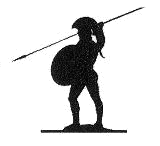|
The story of the Siege of Troy is
known chiefly from translations of the epic poem, The Iliad, which is
attributed to the poet Homer. Tradition has it that Homer was a blind bard
who lived and wandered on the Aegean coast of Asia Minor. He is referred
to in at least two historical references before AD: Xenophanes of
Colophon, a Greek poet and philosopher, who lived from 570 B.C. to 480
B.C. refers to Homer and the historian, Herodotus, wrote, "Homer lived
four hundred years before my time." This would place Homer at about 850
B.C. However, very little is actually known of Homer and there is even
some doubt as to his existence. There are those who argue that Homerís
culture exhibited no tradition of written literature at that time and that
textual analysis suggests that the author of the Iliad was therefore not
one man but a group of bards, or a succession of wandering poets, each of
whom added of his inspiration to the epics.
It is also sometimes argued that there was no historical siege of Troy and
that the story of the war is but the poetís creation. However, many Greek
and Latin authors referred to the event, although their source was
invariably Homer, and they date the Trojan War as follows: 1184 B.C.
(Eratosthenes), 1209/8 B.C. (the Parian Marble), ca. 1250 B.C.
(Herodotus), and 1334/3 B.C. (Douris). Among the early authors Aeschylus,
Sophocles and Euripides wrote cycles of tragedies dealing with the
personalities of the Homeric epics and with their families, and Virgilís
Aeneid, telling the story of Aeneas, one of the defenders of Troy, is
famed as an emulation of Homerís Odyssey.
The Iliad tells that the Trojan War erupted after the wildly beautiful
Helen (the face that launched a thousand ships) left her husband Menelaus,
the king of Sparta, and eloped with Paris, a prince of Troy. The Greeks
laid siege to Troy for ten years without success. Then the siege was
lifted and the Greeks apparently sailed away, but a large "horse"
fashioned from wood was left outside the gates of Troy. The "horse" was,
in fact, hollow and contained a band of armed Greeks. The Trojans opened
their gates and drew the wooden horse inside. That night the concealed
Greeks emerged from the Trojan Horse and to open the city gates to
facilitate the sack of Troy by the returning Greek army.
It is often said that it is unlikely that the siege of Troy could really
have lasted for ten years when the Iliad reports that the Greek army
outnumbered the Trojans by a factor of ten to one. However, the text of
the Iliad also suggests that the Greeks did not blockade the city, which
was supplied from the sea by its allies and was therefore immune to the
depravations of famine and disease that normally result in the inhabitants
of a besieged town surrendering. Furthermore, military strategists
speculate that the greatest part of the Greek army would have been forced
to expend its efforts in sacking the vassal cities of the Trojan Empire in
order to obtain the plunder needed to barter for the supplies and
provisions necessary to feed and clothe the Greek warriors.
The site of the city of Troy is generally accepted as being at Hissarlik,
a low hill near the Dardanelles on the Aegean shore of Turkey. The German
archaeologist, Heinrich Schliemann, discovered the site in 1871 after
analysing topographical detail in ancient writings and located the remains
of nine settlements, one beneath the other. Schliemann discovered a great
treasure among the ruins of the second city from the bottom and this led
him to believe this was the Troy of Homer. However, modern archaeologists
believe that the remains suggest that the seventh city from the bottom was
destroyed by fire around 1200 B.C., which agrees with the traditional date
for the destruction of Homer's Troy around 1184 B.C. It is therefore this
settlement that most believe to be the Troy sung of by Homer. The site was
added to the UNESCO World Heritage List in 1998.
|
